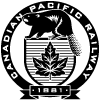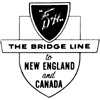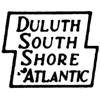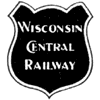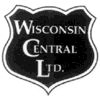Canadian Pacific, like its American counterpart Union Pacific, has the “right” name, one that endures, though CP is younger, having been incorporated in 1881 to build from near North Bay, Ontario, to the Pacific Coast at what is now Vancouver, B.C. Post-World War II subsidiaries that maintained some identity included Esquimalt & Nanaimo; Quebec Central; Dominion Atlantic; and Toronto, Hamilton & Buffalo (owned half by New York Central). After CP obtained full ownership of Soo Line, CP began downsizing, shedding mainly prairie branch lines and lines east of central Ontario. The label “CP Rail,” was in use for nearly two decades while the company was an arm of Canadian Pacific Ltd. Later renamed Canadian Pacific Railway, the rail subsidiary was spun off in 2001 as an independent company, retaining its historic name and beaver logo.
Delaware & Hudson, calling itself the longest-lived transportation company in the U.S., dates to an 1823 charter of the Delaware & Hudson Canal Co. “The D&H” operated the first steam locomotive on rail in the U.S., the Stourbridge Lion, in 1829. Amid modern Northeastern U.S. railroad uncertainty, D&H came under Norfolk & Western’s wing in 1968; returned to independence in 1972; expanded as a forced competitor to the new Conrail in 1976; was acquired by Guilford Transportation in 1984; was placed in bankruptcy by Guilford in 1988; was sold to Canadian Pacific in January 1991; became part of subsidiary St. Lawrence & Hudson in 1996; reverted back to CP in 2000; and was placed under control of the Soo Line in 2001. D&H remains a Soo subsidiary but is operated as part of CP’s overall system.
Minneapolis, Sault Ste. Marie & Atlantic was incorporated in 1883 to build from the Twin Cities east to a connection with Canadian Pacific. In 1888 MSSM&A, Minneapolis & Pacific, and two others consolidated to form the Minneapolis, St. Paul, & Sault Ste. Marie. The nickname “Soo Line” comes from the pronunciation of the word Sault. On December 31, 1960, MStP&SSM merged with subsidiaries Wisconsin Central Railroad and Duluth, South Shore & Atlantic to form Soo Line Railroad. CP for decades owned 56% of Soo, and tried in the 1980’s to sell it, but in 1990 wound up acquiring full ownership. Soo remains a CP subsidiary but is operated as part of the system.
Milwaukee & Waukesha Rail Road chartered in 1847, opened in 1850 as Milwaukee & Mississippi. Milwaukee & St. Paul, an 1863 reorganization of the 1858 La Crosse & Milwaukee, in 1872 acquired the St Paul & Chicago. In 1873 it built from Milwaukee to Chicago and added “Chicago” to its name to become CM&StP. Between 1905-09 it built the Pacific Extension to Seattle and Tacoma. After a 1925 bankruptcy, it emerged in 1928 as Chicago, Milwaukee, St. Paul & Pacific. Bankrupt again in 1977, it shed the Pacific extension and other lines in 1980-83, then was courted by Chicago & North Western, Grand Trunk Western, and Soo Line, and was awarded to Soo in February 1985. Soo Line merged the Milwaukee Road on January 1, 1986.
MN&S was incorporated in 1918 to take over the Minneapolis, St. Paul, Rochester & Dubuque Electric Traction Co.-the “Dan Patch Lines”-which despite its name was never electrified, using steam for freight and pioneer gas-electric power for its interurban passenger service. It became a profitable 87-mile Minneapolis-Northfield local industrial pike and was acquired by Soo Line on June 2, 1982.
Duluth, South Shore & Atlantic Railway incorporated in 1887 as a consolidation of several Upper Michigan ore-country railroads. The “South Shore” came under Canadian Pacific control in 1890. It was reorganized in 1949 after a 12-year bankruptcy as Duluth, South Shore & Atlantic Railroad. Name changed to Soo Line Railroad as the DSS&A corporate structure survived in the December 31,1960, amalgamation with Soo and WC.
Wisconsin Central Railway incorporated in 1871, reached Ashland, Wis., in 1877; St Paul, Minn., in 1884; Chicago in 1886; and Superior in 1908. Leased by Northern Pacific 1890-93. Leased in 1909 by MStP&SSM-which gained access to Chicago, north-country ore deposits, and Wisconsin’s Fox River valley-until WC’s 1932 bankruptcy, after which Soo was WC’s “operating agent.” WC was folded into Soo Line Railroad in the 1960 merger.
Soo Line, after trying in 1987 to establish an “internal regional” with relaxed work-rules on most of its own lines in Wisconsin and Upper Michigan, as the Lake States Transportation Division, gave up the attempt in order to concentrate on its new system including the Milwaukee Road and sold off Lake States’ 2300 miles of track to a group of investors who reused the name, and emblem (which dated from 1885), of the prior railroad on the majority of its lines. Wisconsin Central Ltd. ultimately grew to a 3000-mile system, including Fox Valley & Western, Algoma Central Railway, and Sault Ste. Marie Bridge Co., the terminal firm used as the corporate entity to acquire 220 miles of ex-C&NW Upper Michigan lines from Union Pacific on January 27, 1997. Wisconsin Central Ltd. was acquired by Canadian National on October 9, 2001, providing the missing link in CN’s Y-shaped transcontinental system.





